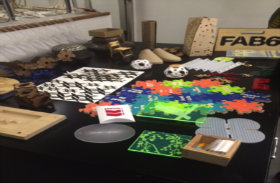STEM: Where Are the Girls??
A MiddleWeb Blog

Veteran teacher Laura Reasoner Jones, founder and director the GEMS Club (Girls Excelling in Math and Science), points out that our daughters are missing out on exciting, challenging careers with opportunities for high salaries and long-term growth potential. And the world at large is missing out on the innovative ideas and contributions of millions of women who have the dispositions we associate with STEM-related work.

Laura Reasoner Jones
Even if women don’t go into STEM, they need a foundation of STEM knowledge and practices to participate in a healthy 21st century democracy. We need to fix this problem, but before we can come up with a solution, we need to answer an important question: Why aren’t there more girls or women in STEM courses and fields? In other words, what’s the problem?
Let’s tackle that question – but understand this . . . I don’t have the answer. I’m just exploring the question. Perhaps you have some ideas to share in the comments section.
What’s the problem with girls, women and STEM?

Blair focuses on increasing the quality of and access to STEM education, especially for girls, so I asked her: Do women actually want to go into STEM fields? And, if so, what’s stopping them?
Blair identified three obstacles detrimental to bridging the gender gap:
1. A lack of fellow girls and young women in STEM classes. According to Blair, the problem is fundamentally one of sustained interest. The lack of women already in the career pipeline is really to blame here. It’s challenging for women to pursue a professional path where they are very clearly lacking in numbers. Many young women leave STEM degree programs despite their good academic standing, often citing uncomfortable classroom experiences and a climate where they feel isolated.

Blair Blackwell
2. The lack of role models and mentors. Ongoing encouragement and support is critical. It’s one thing to get children interested; it’s another to assist them through their educational career to ensure that each young woman has the champions she needs to succeed in STEM should she desire to do so.
3. Societal stereotypes. I wondered if girls would be more interested in STEM pursuits if they involved challenges such as home architecture, toy design, formulating makeup, etc. Blair responded thoughtfully, While I’m a proponent of getting students involved in STEM through a multitude of means, I don’t think we need to pigeonhole women into historically female oriented fields to spark interest.
Blair’s opinion has a lot of support. A recent article from SFGate asserts that making STEM challenges too “girly” may push girls away. Typical engineering issues of everyday life are equally appealing to girls – especially challenges that involve making the world a better place. Reminding girls of stereotypes using phrases like “pink tech” and “web diva” is not the way to engage them enthusiastically in STEM careers, suggests Elizabeth Losh, a digital culture scholar at UC San Diego.

Nisha Cooch
Neuroscientist Nisha Cooch offers yet another perspective. She suggests that the difference in numbers of women in STEM jobs may result from both biological and cultural influences. As infants, girls focus on faces while boys focus on mechanical objects. Females and males also show different neural activation patterns during performance of cognitive tasks on which they perform equally well.
Thus, Cooch says, girls and boys process information and learn in different ways, and their academic performance and choices may differ based on how they are taught. While women and men have comparable abilities in STEM subjects, biology may partly explain the difference in their tendencies to choose careers in STEM and in what sorts of STEM careers might be of most interest.
How do we solve the problem and engage girls in STEM?
Build interest in STEM subjects from a young age. Blair suggests immersing girls in interesting STEM projects and allowing them to design, prototype, and physically create anything they want using tools like laser cutters and 3-D printers. Give them opportunities to use their creativity and practice problem-solving – two elements of STEM that particularly appeal to girls. She points out the importance of opening girls’ eyes to just how exciting these fields can be and instilling that initial interest in them at a young age.
- Support girls and women through mentors and role models. Sustained mentorship efforts help to achieve the goal of getting women to pursue careers in STEM. Young women also need female role models who currently working in STEM jobs, taking STEM courses, and becoming STEM leaders. Blair points out that these female mentors must be available and active in attracting and retaining women in academics and business, especially in the historically male dominated STEM fields. As an example, women employees of Chevron partner with Techbridge to serve as role models and mentors, giving lessons on geology and computer science and encouraging young women to study science and engineering.
- Engage the support of men. I did a double-take when I saw the title of this Washington Post article. One key to having more women in STEM is . . . okay . . . wait for it . . . men!
James LaPlaine
According to the author, James LaPlaine, more men need to step up to the plate and create a culture of inclusion for women – a climate where sexism, dismissiveness and gender prejudices are not tolerated. He sees this as both common sense and a necessity. Men like LaPlaine, who supports a GEMS Club initiative – certainly can be influential in making this a reality.
What can YOU do about girls and STEM?
The answer to this would fill a book. However, I’ll point out three quick ideas.
Laura Reasoner Jones developed a “GEMS CLUB Toolkit” that gives you everything you need to start and run your own GEMS club for school-age girls ages 8 to 13.
- Chevron partnered with Techbridge to produce a guide, Science: It’s a Family Affair, to help parents engage children in engineering experiences.
- You’ll find 10 excellent suggestions on pages 29 and 30 of the Girl Scouts’ Generation STEM: What Girls Say about Science Technology, Engineering, and Math.
If you simply go online and type “girls and STEM,” you’ll encounter plenty of resources to explore. Maybe you’ll catch the “more girls in STEM” bug and create some initiatives of your own!

 Build interest in STEM subjects from a young age. Blair suggests immersing girls in interesting STEM projects and allowing them to design, prototype, and physically create anything they want using tools like laser cutters and 3-D printers. Give them opportunities to use their creativity and practice problem-solving – two elements of STEM that particularly appeal to girls. She points out the importance of opening girls’ eyes to just how exciting these fields can be and instilling that initial interest in them at a young age.
Build interest in STEM subjects from a young age. Blair suggests immersing girls in interesting STEM projects and allowing them to design, prototype, and physically create anything they want using tools like laser cutters and 3-D printers. Give them opportunities to use their creativity and practice problem-solving – two elements of STEM that particularly appeal to girls. She points out the importance of opening girls’ eyes to just how exciting these fields can be and instilling that initial interest in them at a young age.
 Laura Reasoner Jones developed a “
Laura Reasoner Jones developed a “




























Anne, keep the “A” in steam, and let teachers talk to their peers and experiment and learn how to do it better. I am positive girls can, with well-thought-out and carefully arranged set-up, craft imaginative and insightful artwork that reflects productively on deep principles of natural sciences equally well as, and perhaps more readily than boys. The question seems to be one of accepting different modes of processing and expressing ideas, and of recognizing and acknowledging the validity of these modes in entertaining ‘scientific’ ideas. Teachers need to model creativity and expect it and create opportunities for it in student output.
Best,
Gary
I’m more and more beginning to believe in the value of your suggestion, Gary. Within the broad scope of the arts lie much content and skill that can bring insight and benefit to STEM projects and products. Feel free to add some ideas of your own.
Anne, well said! I definitely agree that engaging girls in STEM will require building an interest in STEM subject from a young age. As a girl in STEM (currently a student in bioinformatics) becoming more and more aware of the lack of girls in my surroundings, I recently created this website http://www.custemized.org/ to encourage girls to envision themselves in STEM by providing free, personalized ebooks where they are placed into various STEM careers. Guess I’ve caught the “more girls in STEM” bug! Anyways, I hope http://www.custemized.org/ will be a useful resource for parents who are hoping to encourage their girls to pursue STEM.
Best,
Jean
That “intervention” sounds right on target, Jean. Societal norms still place girls in more traditional roles. Girls need the opportunity to visualize themselves in STEM careers, and it sounds as if you’ve hit on a way to do this early in their lives. You saw a real-life problem, planned and designed a possible solution, and you are likely in the “testing” phase of the engineering design process now. Sounds like a good STEM project from your end as well.